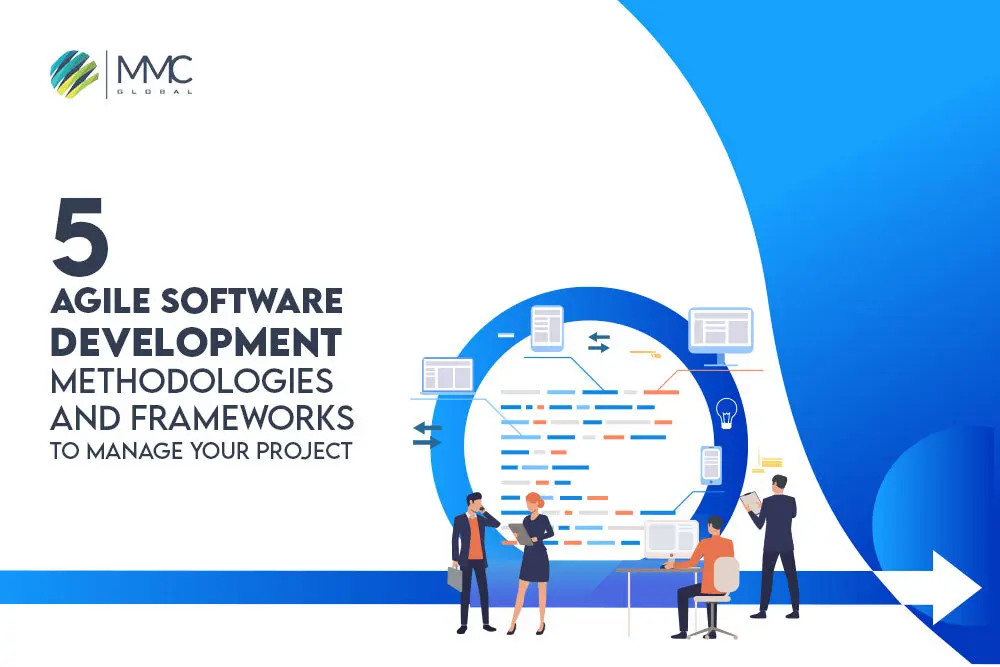5 Agile Software Development Methodologies and Frameworks to Manage Your Project


The project scope is based on various aspects, such as determining and documenting specific project goals, deliverables, tasks, costs, and timelines. Collectively, it specifies how to work on the project to complete it at the right time and make your client satisfied. In the IT industry, project management tools and methodologies ensure on-time deliverables. One of the worth mentioning software development methods is “Agile software development methodology,” which has been recorded as the best implement methodology with a 64% success rate.
However, there is a long story of the success of agile software development that we will conclude in this article. Let’s start with a general introduction!
What is Agile Software Development Methodology?
The agile software development methodology connects the product development process with the needs of users and the customer’s desires. In fact, it is the amalgamation of how to work, collaborate and handle uncertainty across the project development.
To sum up, Agile software development methodology contains
- A user-focused ad result-oriented approach.
- Adaptive nature to survive in ever-changing technology.
- Flexibility and short-time deliverables for the project.
- Continuous optimization to ensure software quality.
Agile software development is a wholesome approach to achieving timelines by understanding user needs and client requirements. In this approach, software development teams can change the plan whenever needed. It is better to accept mistakes at the initial stage rather than go a long way and get back to the first step.

You can reduce time and cost by analyzing errors and flaws during project development. Moreover, team collaboration is a vital part that defines agile methodology. This method teaches you to be transparent with your client and team members regarding the project’s progress.
The agile software development methodology splits into small tasks called user stories. Furthermore, Agile software development has 3C’s, which include Cards, Conversation, and Confirmation.
Cards: The user stories are further split into small, manageable chunks that can be easily monitored and evaluated. It helps developers to cover their maximum work in a short time and do inform their project managers.
Conversation: Conversations with team members or clients are transparent in the agile approach. To keep everyone in the loop, you can efficiently complete your task, monitor backlogs, and always align with the client’s requirements.
Confirmation: Approval from the client side is necessary before any of it goes live or is added to a live environment. It helps to overcome alarming situations before getting worse so that developers can take necessary precautions to ensure software quality.
5 Agile Framework & Methodologies
Scrum
It is one of the most-used agile frameworks to manage tasks and organize teams based on values, principles, and practices. In fact, the scrum framework is highly self-learning-oriented and learns through challenges and experiences. There are 8 popular steps to run a scrum framework, such as:
- Choose a product owner – get the project from a client who helps you define the goal and outcome.
- Create a team – based on the expertise required to initiate the project.
- Onboard a scrum master – to evaluate project progress by monitoring tasks assigned to the team.
- Prioritize product requirements – necessary to fulfill prior requirements and achieve milestones to cover large aspects.
- Split tasks into sprints – a small chunk of a big project would help complete a major portion. A sprint consists of 2 weeks of planning in which the project manager assigns tasks or individuals can decide on their duties with timelines.
- Do stand-ups with the team – to know the team member performance and project progress.
- Arrange review and get feedback – deliver whatever task has been done to the clients and project manager to evaluate at the first stage and get feedback to improve.
- Do a retrospective.
Extreme Programming
This agile framework will help to create high-quality software due to its transitory nature or dynamic software exchanging requirement. It encourages developers to improve products in real time by implementing changes right away. It goes through 4 stages:
Coding -That is the major weapon for developing projects.
Testing – Before writing a code, testers must create test cases to evaluate.
Planning – Encourages taking steps carefully for the final build and separate iterations.
Listening – A healthy discussion between developers and clients to redefine the values and requirements and eliminate setbacks.
Feature-Driven Development (FDD)
The feature-focused approach makes software development more customer-centric and feature-rich. FDD follows a customer-centric approach and mainly builds customer-driven features to regulate the whale software development process.
This agile software development consists of 5 cyclic steps:
- Create an object model
- List down the features
- Plan by features requirements
- Futuristic designing of the feature
- Develop with the best coding and then repeat.
Agile Data Method (ADM)
This agile software development methodology helps continuously collaborate within the team to maximize efficiency and make suitable decisions during the project development. Six assessments require alignment agile data method.
Project problem – to spot the problem and lag within the project, you must understand your whole project’s purpose.
Working Groups – this method prefer team and within-team development to attain project goal more efficiently.
Uniqueness – Uniques and creative projects always come up with the association of multiple tools and procedures. That is why this method encourages developers to ensure every possible incorporation.
Teamwork – the more cohesive team you build, the more efficiently and timely you deliver the project.
Read more: Top 5 Tools for Fostering Agile Methodology in Your Company
Other Methodologies…
There are 6 agile software development frameworks and methodologies applicable to different practices and values. It includes lean software development, essential unified process, agile unified process, crystal methodologies, agile modeling, and dynamic software development method. Moreover, you can get a free consultation with our professional project managers to understand more about them.
We highly adapt new methodologies and techniques to get hands-on experiences for better understanding. Our exceptional project management approach will help to achieve thousand of tech projects around the globe. Request a consultation and start managing your project without any ambiguities!



